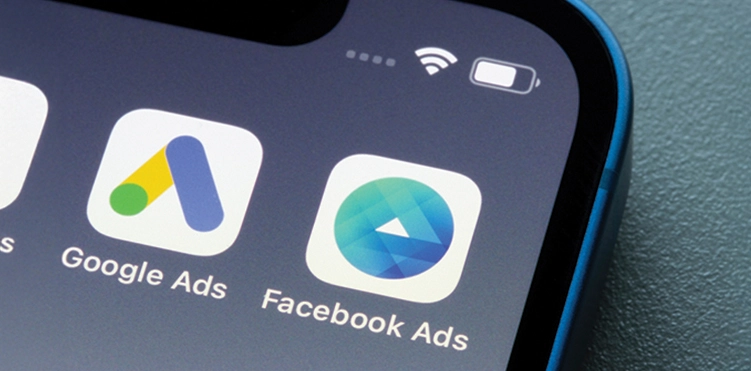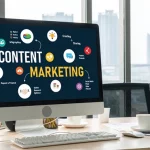It is no secret that the platforms businesses choose for advertising significantly impact their performance. With the increase in social media apps and platforms, entrepreneurs are spoilt for choice. On the other hand, the rise of programmatic advertising and automated media buying in India is transforming how brands approach their online campaigns. Google and Facebook are among the most popular platforms, remaining at the forefront of digital marketing.
As of 2025, Facebook is reported to have over 3 billion monthly users, while Google’s search engine is accessed by nearly 5 billion individuals. Of these, studies indicate that approximately 500-580 million Facebook users and around 400 million daily Google users are in India, highlighting the importance of these applications for digital marketing.
Although Google and Facebook dominate digital ad spending, they serve very different purposes. Google Ads captures active search intent, while Facebook Ads excels in discovery and engagement. For both startups and established companies, understanding these differences and their connection to broader digital advertising trends in India is crucial.
This blog aims to provide a comprehensive side-by-side comparison of Google Ads and Facebook Ads, including real-world examples, to help you determine which platform aligns best with your business goals this year. Along the way, we will also explore how new approaches such as programmatic advertising can enhance your strategy for faster and smarter growth.
Key Takeaways: Google Ads vs. Facebook Ads
- Google Ads: Focuses on demand capture, making it ideal for reaching high-intent users who are actively searching for products and services.
- Facebook Ads:Emphasisesdemand creation, which is excellent for storytelling, brand building, and generating interest among audiences.
- Cost: Google Ads typically has a higher cost-per-click (CPC) but targets users with stronger purchase intent. On the other hand, Facebook Ads are generally more cost-efficient for reaching a wider audience, although they may require additional effort in nurturing leads.
- Return on Investment (ROI): Google Ads often yields quick wins in terms of conversions, while Facebook Ads excel at fostering long-term brand engagement.
Google Ads vs. Facebook Ads: Key Differences at a Glance
User Intent: Search vs. Discovery
- Google Ads: Target users who are actively searching for solutions, indicating a high purchase intent.
- Facebook Ads: Focuses on users based on demographics, interests, and behaviours, often engaging those who are not actively searching..
Reach and Audience Size
- Google: Processes over 5 trillion searches annually, making it ideal for capturing specific queries.
- Facebook: Boasts over 3 billion monthly active users across Facebook, Instagram, Messenger, and WhatsApp, making it great for reaching large, diverse audiences.
Targeting Capabilities
- Google Ads: Offers targeting through keywords, search queries, remarketing lists, demographics, device targeting, and time-based targeting.
- Facebook Ads: Targets users based on demographics, interests, behaviours, life events, and lookalike audiences created from customer data.
Ad Formats and Creativity
- Google Ads: Primarily uses text-based search ads, shopping ads, display banners, and YouTube video ads.
- Facebook Ads: Focuses on visual content, including images, videos, carousel ads, instant experiences, and collection ads designed for discovery.
Cost Comparison and ROI Potential
- Google Ads: Typically has higher cost-per-click (CPC) rates, especially in competitive niches like insurance or real estate, but the clicks generally convert better due to the strong intent behind them.
- Facebook Ads: Offers lower CPC rates, making it excellent for reach and engagement, but conversion often requires retargeting and multiple touchpoints.
What is Google Ads?
Google Ads, formerly known as Google AdWords, is the world’s largest and most popular PPC or pay-per-click advertising platform. Google Ads has become synonymous with the term “paid search.”
How do Google Ads work?
As mentioned earlier, Google Ads operates on a pay-per-click model and allows advertisers to select the ad type that best suits their business needs. In this model of digital advertising, the advertiser pays a fee only when their ad is clicked. Some of the available ad types include search ads, display ads, and Google Shopping ads. Among these, search ads are the most popular because they enable users to create text-based advertisements that appear on search result pages when relevant keywords are used.
This enables advertisers to target their ideal customer base based on search intent using keywords they search for, plus demographic details like age, gender, location, family status, and household income.
Google Ads Formats for E-commerce
Google Shopping Ads
Google Shopping Ads are among the most effective advertising formats for e-commerce businesses. They enable products to appear directly in search results, showcasing rich details such as product images, prices, ratings, and store names. Unlike simple text ads, Shopping Ads provide potential buyers with a visual snapshot of what you’re offering before they even click through. For example, if a customer searches for “running shoes online,” they will instantly see a row of product options from multiple retailers, complete with photos and price comparisons. This high visibility drives clicks and attracts purchase-ready traffic.
Dynamic Search Ads
Dynamic Search Ads (DSAs) automatically generate ads based on the content of your website. Instead of manually creating ad copy for every keyword, Google’s algorithm crawls your site and matches user search queries to relevant pages. For instance, if a user searches for “best budget laptops 2025” and your site has a page dedicated to laptops under a specific price point, Google will dynamically pull that content to display a highly relevant ad. The main advantage of DSAs is that they save time, capture long-tail searches that you might have overlooked, and ensure that the ads remain aligned with your website content without requiring manual updates.
Local Inventory Ads
Local Inventory Ads connect e-commerce with physical retail. These ads showcase products available for nearby shoppers, including their current stock status at local stores. For example, if someone searches for “iPhone 15 Pro near me,” they may see your store’s ad indicating that the phone is available for pickup today at their nearest location. This approach is particularly effective for categories like electronics, apparel, or household goods, where customers often prefer same-day purchases over waiting for delivery. Local Inventory Ads help drive foot traffic, build trust by displaying real-time availability, and provide measurable ROI by linking digital ads directly to offline conversions.
Advantages of Using Google Ads
Extensive Reach
Google leads the search engine market with billions of daily queries. Its reach extends even further through YouTube and over 2 million websites in its Display Network.
High Purchase Intent
Users searching for terms like “best gym near me” or “buy DSLR camera” are often ready to make a purchase. Google Ads effectively captures this demand.
Fast Results
Unlike SEO, which can take months to show results, Google Ads can drive traffic and generate leads almost immediately. This makes it perfect for product launches or time-sensitive promotions.
3 Examples of Successful Google Ads Campaigns
- Starbucks India has successfully used Facebook Ads to run limited-time offers like “Happy Hours – Buy One Get One Free” within a specific radius of their outlets in metros like Delhi and Mumbai. The brand tapped into office-goers and students nearby.
- Zara uses Instagram video ads and reels to announce new collections. These campaigns consistently generate high engagement and direct sales traffic to their app.
- Charity: Water ran emotionally powerful video ads on Facebook, generating donations and building awareness globally.
What are Facebook Ads?
Facebook Ads are targeted advertisements that appear across Meta platforms. These ads can include images, videos, and reels. They typically resemble regular posts but feature a “sponsored” label under the username.
Unlike Google Ads, Facebook Ads target users based on their interests, behaviours, the pages they follow, and significant life events, such as getting married or buying a home. Facebook offers both pay-per-click (PPC) campaigns and pay-per-impression (PPM) campaigns, where you are charged for every 1,000 impressions.
Facebook Ads Formats for E-commerce
Image Ads
Image Ads are one of the simplest yet most effective formats for e-commerce on Facebook and Instagram. They allow businesses to showcase a single product with a strong visual and a clear call to action. This format is particularly effective for highlighting bestsellers or new launches.
For example, Nykaa frequently uses image ads to spotlight seasonal lipstick shades or limited-time offers, driving users directly to the product page. Since these ads appear natively in users’ feeds, they feel less intrusive and more like natural content, enabling brands to capture attention quickly.
Video Ads
Video Ads are ideal for storytelling, product demonstrations, and engaging users who are casually scrolling through their feeds. They can appear in feeds, stories, or reels, offering versatile placement opportunities. For e-commerce, video is particularly powerful because it combines visuals, sound, and motion to create a stronger emotional connection.
For instance, Myntra often launches campaigns using video ads to showcase new fashion collections, featuring models wearing the outfits, giving users a virtual “try-before-you-buy” experience. These ads help create brand identity and foster emotional engagement.
Carousel Ads
Carousel Ads enable businesses to feature multiple products or highlight different features of the same product within a single ad unit. Each card can include its own image, description, and link, making this format dynamic for catalogue promotions.
For example, Decathlon India effectively uses carousel ads to showcase a variety of categories, from cycling gear to running shoes, in one campaign. This format encourages users to browse through an assortment without leaving the app, promoting deeper engagement and increasing the likelihood of finding something relevant.
Collection Ads
Collection Ads are similar to Google Shopping Ads on Facebook. They combine a primary image or video with a product catalogue, creating an immersive in-app shopping experience on both Facebook and Instagram. When users click on a Collection Ad, they enter an “Instant Experience”, a fast-loading, mobile-optimised storefront within the platform.
For example, H&M frequently utilises collection ads to launch new seasonal lines, allowing users to tap into the catalogue, browse styles, and even make purchases without leaving Facebook or Instagram. This format reduces friction in the customer journey, making it particularly effective for impulse-driven purchases and mobile-first shoppers.
Advantages of Using Facebook Ads
Advanced Targeting Options
Facebook’s granular targeting lets businesses reach audiences based on life stages, interests, and online behaviours. A baby products startup, for instance, can target “new parents within 5 miles of Bangalore.”
Brand Building with Memorable Ads
Visual-first formats are ideal for storytelling. For example, Dove’s Real Beauty campaigns on Facebook resonated emotionally with audiences, strengthening brand loyalty.
Remarketing Capabilities
Facebook’s Pixel enables retargeting. For instance, an e-commerce brand can re-target users who abandoned their carts with a carousel ad featuring the exact products they viewed.
3 Examples of Successful Facebook Ads Campaigns
- Starbucks India has successfully used Facebook Ads to run limited-time offers like “Happy Hours – Buy One Get One Free” within a specific radius of their outlets in metros like Delhi and Mumbai. The brand tapped into office-goers and students nearby.
- Zara uses Instagram video ads and reels to announce new collections. These campaigns consistently generate high engagement and direct sales traffic to their app.
- Charity: Water ran emotionally powerful video ads on Facebook, generating donations and building awareness globally.
When to Use Google Ads vs. Facebook Ads
| FACTOR | GOOGLE ADS | FACEBOOK ADS |
|---|---|---|
| Business Goals & Platform Selection | For immediate conversions from high-intent searches. | For brand awareness, engagement, and storytelling. |
| Industry-Specific Considerations | E-commerce: Excels at reaching purchase-ready audiences actively searching. | Lifestyle brands: Stronger for building communities and driving aspirational purchases. |
| Budget Considerations | Suitable for high-value sectors (e.g., finance, B2B SaaS) where every lead has significant ROI. | With limited budgets, offers a broader reach and affordable exposure. |
How to Use Google Ads and Facebook Ads Together
Google Ads and Facebook Ads are more powerful and effective when used together. Instead of choosing just one, it would be ideal to develop a comprehensive plan and strategy that incorporates both.
Creating a Complementary Strategy
Ensure that your Facebook and Google ads work together effectively. Capture interest in your products or services using creative imagery and videos on Meta’s social media platforms. Then, utilise Google Search and Shopping ads to convert this traffic of high-intent buyers into actual customers.
Budget Allocation Across Platforms
Established brands should allocate about 60-70% of their budget to Facebook Ads, with the remaining 30-40% directed to Google Ads. In contrast, startups should focus more on Google Ads, as they must enhance their visibility amidst competition.
See How 7000+ Marketing Agencies Help Clients Win
A recent survey showed that over 7,000+ agencies globally use blended ad strategies. There has been a big shift in programmatic advertising in India, where automated platforms buy and place ads in real-time. Unlike manual bidding, automated media buying allows startups and brands to target the right audience at scale with precision. This complements traditional Google and Facebook campaigns and is becoming a core part of digital advertising trends in India in 2025.
At ODigMa, we’ve seen this dual strategy, search and social plus programmatic ads, deliver stronger ROI for e-commerce brands, healthcare players, and enterprise businesses alike.
Conclusion
The debate between Google Ads and Facebook Ads isn’t about which platform is superior overall, but rather which one aligns better with your specific goals, industry, and budget. Google Ads is unparalleled for attracting high-intent leads and achieving immediate conversions, while Facebook Ads excel at building brand awareness and nurturing customer relationships.
In many cases, the most effective strategy in 2025 will be to combine both Google and Facebook Ads, leveraging each platform’s strengths and closely measuring the results. With the right agency partner, such as ODigMa, you can transform these platforms into powerful engines for growth.
FAQs
1. Which is better: Google Ads or Facebook Ads?
The choice between Google Ads and Facebook Ads largely depends on your business objectives. Google Ads is typically more effective for capturing existing demand, as it targets users actively searching for products or services. In contrast, Facebook Ads excels at creating demand by reaching users who may not yet be aware of what they need.
2. Which platform is cheaper: Google Ads or Facebook Ads?
Generally, Facebook Ads have a lower cost per click compared to Google Ads. However, it’s important to note that while Facebook may offer lower initial costs, Google Ads can often provide higher conversion rates, potentially leading to better overall return on investment.
3. How do I calculate an ad spend budget for Facebook Ads?
To calculate your ad spend budget for Facebook Ads, estimate based on the desired reach you want to achieve, your expected cost per click, and your conversion rate. This will help you determine a budget that aligns with your marketing goals.
4. What are the disadvantages of Google Ads?
One major disadvantage of Google Ads is the higher competition in certain industries, which can lead to elevated costs per click. This competitiveness can make it challenging for smaller businesses to effectively compete.
5. Who generates more revenue from ads: Google or Facebook?
Google leads in revenue generated from search ads, thanks to its robust search engine platform. Meanwhile, Facebook has a strong grip on social media ad revenue, effectively capitalising on its vast user base and engagement metrics.


 Digital Marketing For Doctors In India
Digital Marketing For Doctors In India A Comprehensive Guide to Programmatic Advertising (2025)
A Comprehensive Guide to Programmatic Advertising (2025) How to choose the Best Search Engine Marketing (SEM) agency in Bangalore
How to choose the Best Search Engine Marketing (SEM) agency in Bangalore Social Media Marketing for Healthcare: The 5 Step Plan
Social Media Marketing for Healthcare: The 5 Step Plan Content Marketing for Startups: Building Brand & Driving Growth on a Budget
Content Marketing for Startups: Building Brand & Driving Growth on a Budget